Bayhall Manor at Pembury, Kent
|
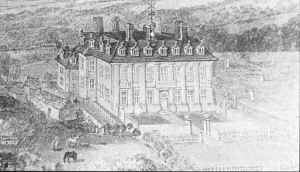
Bayhall: Home of the earliest known Culpepers
Destroyed in 1960
History of Bayhall Manor
Bayhall has been the residence of many well
known families, the earliest being the Culpepers and the Duke
of Buckingham. Later it belonged to the Amherst family.
The manor of Bayhall lay in the valley on the
south side of the village of Pembury. Ruins of the house were
still to be seen until about 1960. At this time one of the
national newspapers told a rather exaggerated story of its being
haunted. People coming to see it made themselves such a
nuisance and rendered it so unsafe, that the owner got permission to clear it away. The ghost was
supposed to be that
of Anne West, the last person to reside in the mansion.
A picture of the mansion at
Bayhall may be seen in the Tunbridge Wells Museum.
Source: Mary E. Standen, History of Pembury,
1984.
Bayhall Manor
Dates, Ownership, Generation No., (Monarch)
 |
? - 1247: Sir Thomas Culpeper1
(Henry III) |
 |
1247-1286: Sir John Culpeper2
(Henry III, Edward I) |
 |
1286-1312: Sir Thomas Culpeper3
of Brenchley and Bayhall
(Edward I, Edward II) |
 |
1312-1321: Sir Thomas Culpeper4
of Bayhall
(Edward II) |
 |
1321-1323: Walter Culpeper5
(Edward II) |
 |
1323-1327: Due to an act of rebellion by
the Culpepers,
Edward II seized Bayhall and other Culpeper properties and
held them for several years. |
 |
1327-1372: Sir John Culpeper5
of Bayhall and Hardreshull
(Edward III) |
 |
1372-1428: Sir Thomas Culpeper6
of Bayhall, Hardreshull and Exton
(Edward III, Richard II, Henry IV-VI) |
 |
1428-1430: Sir John Culpeper7 of
Bayhall, Hardreshull and Exton
(Henry VI) |
 | 1430-1462: Walter Culpeper Esq7
of Goudhurst, Bayhall and Hardreshull
(Henry VI, Edward IV) |
 |
1462-1480: Sir John Culpeper8
of Bayhall, Hardreshull and Bedgebury
(Edward IV) |
 |
1480: Manor sold to Humphrey Stafford, Duke of Buckingham. |
N.B. The names in bold above are direct ancestors of the
modern-day Culpeppers. They owned Bayhall from the mid 1200s to
1480.
The ownership of Bayhall for the first two generations is
assumed by Culpepper Connections but not directly stated
by Hasted. Source: Edward Hasted, The
History and Topographical Survey of the County of Kent,
Canterbury: W. Bristow, Originally published 1797-1801,
Reprinted 1972, Vol. 5, pp 264-271 (complete
text regarding Bayhall from p 271)
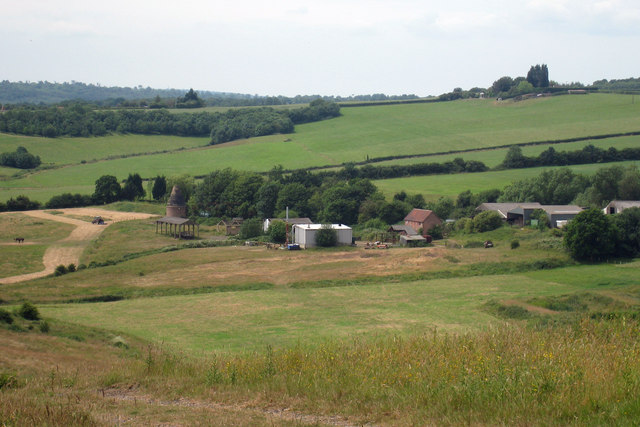
Great Bayhall Farm, Chalket Lane, Pembury, Kent
© Copyright Oast
House Archive and
licensed for reuse under this
Creative Commons Licence. Location:
On Chalket Lane, 0.7 miles South of High Street in Pembury
6 miles WNW of Goudhurst
National Grid Coordinates:
TQ6239
(Click for interactive map)
|
Dencrouch, Highlands and Prigles Manors
Dencrouch, Highlands and Prigles are
three small manors in Pembury which formerly
belonged to the Christian abbey of Robertsbridge in Sussex, until the
dissolution, when the abbey went into King Henry VIII's hands. Granted to George
Guldeford, Esq., he sold them to Sir Alexander Culpeper9
(1479-1541) of Bedgebury, who had a confirmation of them
from the Crown in about 1543.. His
great-grandson Sir Anthony Culpeper12 (1560-1618)
sold these manor's to Nicholas Miller of Wrotham, circa 1605.
Source:
Hasted, History of Kent, Vol. V, page 268
There is no evidence of these manors in 2000,
not even in similar names used in the area. |
History of Pembury
Pembury is situated on the southern border of
the county of Kent. It was formerly in the rural district of
Tonbridge, but is now in the Tunbridge Wells district. It is in
the diocese of Rochester, within the Hundred of Washlingstone
and the lay of Aylesford. It has been a place on the map for
very many years under various names. The first one was
Pepingeberia, and then Pepenbury. Pepingeberia was a village of
some importance years before the existence of Tunbridge Wells.
Indeed, in recent years evidence of prehistoric man (a flint
arrowhead and a flint for skinning wild animals) has been found
in the village.
Originally Pepingeberia was a clearing in the
vast forest of Anderida, which covered practically the whole of
Kent and Sussex and a part of Hampshire. The area of the parish
is approximately 6 1/4 square miles. For hundreds of years it
must have been a very picturesque place in which to live. It has
been described as being "as pleasant a spot as poet or
artist could wish to repose in; for crystal rills and shady
groves, with smiling corn-fields, here combine to form a joyous
and luxuriant picture." Unfortunately, the Pembury of today
presents a far different picture, although there are still some
pleasant places to be found on the outskirts of the parish.
The first known record of Pembury is contained
in "Textus Roffensis" (c. 1120). It tells of the
manors of Pepenbury Magna and Pepenbury Parva, alias Bowridge (Bopeep). The next mention is of these manors with the advowson
being granted by Simon de Wahull to the abbey of Bayham (c.
1239). So it is evident that there must have been a
church here which was early twelfth or even late eleventh
century. Its ' plan and the remains of Norman architecture also
point to this. The little document concerning this gift to the
Abbot of Bayham is in the County Archives at Maidstone, and is
in a wonderful state of preservation.
Source: History of Pembury, 1984, Mary
E. Standen
The name of Culpepper probably has its roots in Pembury.
See article.
Topographical Dictionary of England
Pembury, a parish in the hundred of
Washlingstone, lathe of Aylesford, county of Kent, 3½ miles
(S.E.) from Tunbridge, containing 891 inhabitants. The church is dedicated to
St. Peter. Several small streams, tributary to the Medway, run
through the parish. |
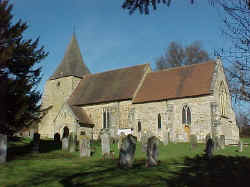 St. Peter's
Old Church, Pembury St. Peter's
Old Church, Pembury
The first certain date is 1337, when most of
the present church was built by John Culpeper5 of
Bayhall. He also built the chantry chapel of St. Mary in the
churchyard in 1355. This chapel was 30 feet long and 18 feet
wide, and was entirely covered with lead. Exactly where this
chapel stood nobody seems to know and, so far, no references
have thrown any light upon it, though foundations of some kind
have been discovered at the east end of the church. It was
pulled down apparently at the Dissolution of the smaller
Monasteries in 1547, and the three windows in the body of the
Church were inserted with the money gained from the sale of the
lead. (Photograph taken by Warren Culpepper in March 2000)
At about the same time as he was restored to
royal favor, John Culpeper5 married a wealthy lady of the
Hardreshull family, and it was her money which helped to build
the church and chantry chapel.
The Parish Church stands on the slope of a
picturesque ridge, surrounded by woodland, and is dedicated to
St. Peter. The stone used in its construction is local
sandstone, and as you look at it you see three distinct dates.
The bottom part of the Nave is of irregular-sized and shaped
stone, which contains quite a lot of iron ore. The tower and
chancel are still all shapes and sizes, but of rather better
workmanship. The three top courses of the Nave are square-cut,
and of a later date, when the roof was raised to allow a gallery
to be installed.
To the right side of the porch is a small
round-headed window, the lower part of which is cut off by the
roof-line of the porch. The window is very small externally, but
is deeply splayed on the interior. This arrangement was a very
common one in Romanesque churches, as it gave security as well
as light, which was a very necessary consideration in those days…
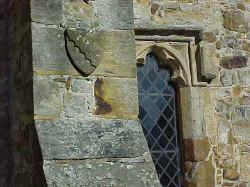 Another interesting feature of the chancel is
the presence of armorial bearings which are cut in relief on the
stones of the buttresses. The three on the south side are
original, as they were placed there when the buttresses were
built. The first to be seen, on the western buttress of the
chancel, are the arms of the Culpeper family, which is a bend
engrailed. Another interesting feature of the chancel is
the presence of armorial bearings which are cut in relief on the
stones of the buttresses. The three on the south side are
original, as they were placed there when the buttresses were
built. The first to be seen, on the western buttress of the
chancel, are the arms of the Culpeper family, which is a bend
engrailed.
(Pictured at the left in a photograph taken by Warren
Culpepper in March 2000)
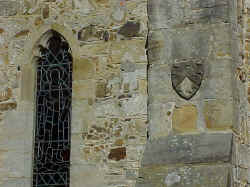 The second armorial bearing, on the central
buttress, is that of the Hardreshull family into which John Culpeper5 married. These arms consist of a chevron
between 8 martlets, viz, 5 and 3, (martins or swallows -
without feet). (Pictured on the right in a photograph taken by
Warren Culpepper in March 2000) The second armorial bearing, on the central
buttress, is that of the Hardreshull family into which John Culpeper5 married. These arms consist of a chevron
between 8 martlets, viz, 5 and 3, (martins or swallows -
without feet). (Pictured on the right in a photograph taken by
Warren Culpepper in March 2000)
The third is a shield bearing a cross, like the
cross of St. George (or, a cross gules), probably the arms of
William, Earl of Ulster… (Not pictured)
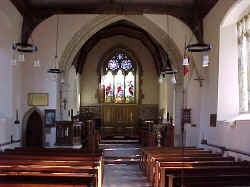 In 1860, the floor of the chancel, which had
been on the same level as the nave, was raised two steps, thus
concealing an interesting old tombstone of one of the Culpepers
set in the original floor. Round the edge are the words
"Pritz pur lame Margarete5 la file Sire Thomas
Culpeper4" written in Lombardic capitals… A
drawing of Margaret Culpeper’s tomb can be seen in the
British museum… (Photograph of interior taken by Warren
Culpepper in March 2000) In 1860, the floor of the chancel, which had
been on the same level as the nave, was raised two steps, thus
concealing an interesting old tombstone of one of the Culpepers
set in the original floor. Round the edge are the words
"Pritz pur lame Margarete5 la file Sire Thomas
Culpeper4" written in Lombardic capitals… A
drawing of Margaret Culpeper’s tomb can be seen in the
British museum… (Photograph of interior taken by Warren
Culpepper in March 2000)
Source: History of Pembury, 1984, Mary
E. Standen, and Hasted, History of Kent, Vol. V, pages
269-270 Location: 6 miles
WNW of Goudhurst, at end of Old Church Road, 0.4 miles N of
the A228.
National Grid Coordinates:
TQ626429
(Click for interactive map) 
|
Bayhall Manor
Complete text from Hasted's History of Kent
THE MANOR OF BAYHALL, which lies in the southern part of this
parish, was part of the antient possessions of the eminent
family of Colepeper, whose demesnes spread over the whole face
of this county, but more especially the western parts of it.
The two principal branches of it were seated at this manor of
Bayhall, and at Aylessord, from the latter descended those of
Oxenhoath, and of Preston, in Aylesford, barts. both now
extinct; and from the former, those of Bedgbury, which
terminated in the lords Colepeper, of Leeds castle; those of
Losenham, in Newenden, afterwards of Hollingborne, the heir male
of which branch is John Spencer Colepeper, esq. late of the
Charter-house, and those of Wakehurst, in Sussex, barts. now
extinct.
The first of the family of Colepeper, eminent on record, is
Thomas de Colepeper, who, as appears by the bundles in the
pipe-office, was one of the recognitores magnæ assise, or
justices of the great assise, in the reign of king John, an
office of no small trust and consequence, before the
establishment of conservators of the peace.
His descendant, Sir Thomas Colepeper, was possessed of the manor
of Bayhall, where he resided, and seems to have left two sons;
Thomas, of whom hereafter; and Walter, who was ancestor of the
Colepepers, of Oxenhoath, and of Preston, in Aylesford,
baronets.
Sir Thomas Colepeper, the eldest son, inherited Bayhall, and was
castellan of Leeds castle under the lord Badlesmere, in the
reign of king Edward II. in the 15th year of which he was
executed, for resusing queen Isabel entrance into his castle,
upon which this manor became forfeited to the crown, whence it
was soon afterwards restored to his son, but whether by that
prince's indulgence, or by any family entail, I do not find.
John Colepeper, esq. the son, kept his shrievalty at Bayhall in
the 39th, 40th, and 43d years of king Edward III. and married
Elizabeth, daughter and coheir of Sir John Hardreshull, of
Hardreshull, in Warwickshire, by whom he had a son, Sir Thomas
Colepeper, who succeeded him in this manor, and resided at
Bayhall. He was sheriff in the 17th and 18th years of king
Richard II. from whom he procured licence to inclose fifty acres
of land into a park at Pembury.
He left by Alianor his wife, daughter and coheir of Nicholas
Green, esq. of Exton, in Rutlandshire, three sons; Sir Thomas
Colepeper, Walter Colepeper, of Goudhurst, ancestor of the
branches of this family settled afterwards at Bedgbury, Losenham,
Leeds, Hollingborne, and Wakehurst, and Nicholas, who ended in a
daughter, married to Walter Lewknor, esq. and also a daughter
Alianore, married to Sir Reginald Cobham, of Sterborough. Sir
Thomas Colepeper, the eldest son, who was of Exton, in
Rutlandshire, (fn. 5) seems to have alienated this manor in the
reign of king Henry VI. to Humphry Stafford, duke of Buckingham,
whose grandson Henry, duke of Buckingham, became one of the
chief considents of Richard, duke of Gloucester, afterwards king
Richard III. and the principal agent in advancing him to the
throne, but being attainted in the 1st year of that reign, his
possessions became forseited to the crown, and the king made a
grant of this manor, to the value of one hundred shillings, to
John Water, alias Yorke Heraulde; but on the accession of the
earl of Richmond to the crown soon afterwards, by the title of
king Henry VII. an act passing for the restitution of Edward,
son and heir of Henry, duke of Buckingham, he became entitled to
the inheritance of all the estates of the late duke, his father,
and he had accordingly possession granted him of this manor
among the rest of them, but this duke being likewise accused and
found guilty of high treason in the 13th year of king Henry the
VIIIth's reign, an act passed for his attainder, and though
another passed likewise for the restitution in blood of Henry,
his eldest son, yet it did not extend to his honors and lands,
which remained forseited to the crown, where the see of this
manor remained till Edward VI. in his 1st year, granted it to
William Parr, marquis of Northampton, who that year conveyed it
to Sir Anthony Browne, knight of the garter, who had been master
of the horse to king Henry VIII. and of his privy council; and
he, in the very beginning of the next year, alienated it to
William Wybarne, one of whose descendants sold it, in the 7th
year of James I. to Robert Sackville, earl of Dorset, who died
possessed of it within a few months after his purchase. His
eldest surviving son Richard, earl of Dorset, alienated this
manor, with the seat belonging to it, to Richard Amherst, esq.
serjeant-at law, who afterwards resided at Bayhall. He was the
son of Richard Amherst, esq. who left three sons; Richard,
serjeant atlaw, as above-mentioned; Jessry, rector of Horsmonden,
ancestor of that branch of the family settled at Riverhead, in
Sevenoke, and William, who left an only daughter. This family of
Amherst bear for their arms, Gules, three tilting-spears, two
and one, erected in pale, or, headed argent; which coat was
confirmed to Richard Amberst, esq. by William Camden,
clarencieux, in 1607. (fn. 6) Sergeant Amherst died possessed of
this estate in 1632.
His grandson, Charles Amherst, esq. was of Bayhall likewise, and
died s.p. in 1709, and by his will devised this manor and seat,
together with all his other lands and possessions, to his nephew
and heir at-law, Charles Selby, esq. son of Sir Henry Selby,
sergeantat-law, and recorder of London, (the second son of
George Selby, esq. of Ightham) by Elizabeth his eldest sister,
at the same time enjoining him to take on him the surname and
arms of Amherst.
Charles Selby Amherst, esq. accordingly inhabited Bayhall, where
he resided, but dying s.p. he by his will gave this manor and
seat of Bayhall, with the rest of his estates, to his nephew
Charles Browne, esq. counsellor-at-law, son of Dorothy his
sister, by John Browne, esq. of Salop. He resided at Bayhall,
where he died in 1753, and was buried in this church, leaving no
issue by Elizabeth Mittel his wife, who survived him, and
afterwards resided here, where she died in 1790, soon after
which this estate was sold to Thomas Streatfield, esq. the
present possessor of it. A court leet and court baron is holden
for this manor.
DENCROUCH, HIGHLANDS, and PRIGLES, are three small manors in
this parish, which formerly belonged to the Cistertian abbey of
Robertsbridge, in Sussex, with which they remained till the
final dissolution of it, when that abbey was surrendered into
the king's hands, with all its lands and possessions; all which
were confirmed to the king and his heirs by the general words of
the act, passed in the 31st year of his reign, for that purpose.
Soon after which, the king granted them to George Guldeford, esq.
(son of Sir Richard, knight banneret, and of the garter) who
quickly after conveyed them by sale to Sir Alexander Colepeper,
of Bedgbury, who had a confirmation of them from the crown,
about the 35th year of that reign. His great-grandson, Sir
Anthony Colepeper, of Bedgbury, alienated these manors in the
beginning of king James I.'s reign, to Nicholas Miller, esq. of
Horsnells-crouch, in Wrotham, when they passed from his
descendants I have not found, only that they afterwards went
into the possession of Pollard, and in 1766 they were the
property of Elizabeth Pollard, widow, since which they have come
into the possession of James Lewin, esq. who now owns them.
From: 'Parishes: Pembury', The History and Topographical Survey
of the County of Kent: Volume 5 (1798), pp. 260-272. URL:
http://www.british-history.ac.uk/report.aspx?compid=62905&strquery=colepeper.
Date accessed: 28 February 2008. |
Last Revised:
02 Jan 2015 |
|